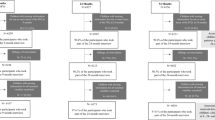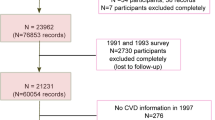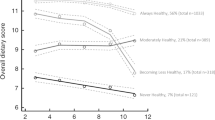Abstract
Objective: To analyze food consumption, nutrient intakes and serum cholesterol concentrations of the parents in a child-targeted CHD intervention trial, during which the age of children increased from 7 months to 5 y.
Design and subjects: The children were randomized to an intervention group (n=540) or a control group (n=522) at six months of age. The intervention families were counseled at 3–6 month intervals to reduce their child’s intake of saturated fat and cholesterol. Dietary issues were discussed with the control families only briefly. The parents’ food consumption was analyzed by 24 h dietary recall at the child’s age of 7 and 13 months and at 2, 3, 4, and 5 y. Nutrient intakes were calculated using the Micro-Nutrica program®.
Results: The mothers and fathers of the intervention children used less butter, more margarine and more skim milk than those of the control children (P<0.001 for all measurements). After the onset of counseling, the intervention mothers consumed continuously less fat (1.4 E% less at the child’s age of 5 y), less saturated fat (1.5 E% less at the child’s age of 5 y) and more polyunsaturated fat (0.5 E% more at the child’s age of 5 y) than the control mothers (P=0.008, P<0.001 and P<0.001 for trend, respectively). After the child’s age of 13 months the intervention fathers also had a continuously lower fat intake (2.4 E% less at the child’s age of 5 y) and consumed less saturated fat (1.5 E% less at the child’s age of 5 y) than the control fathers (P<0.001 for trend for both measurements). The serum cholesterol concentration of the intervention mothers was consistently lower than that of the control mothers during the intervention (at child’s age of 5 y 4.86 and 5.09 mmol/L, respectively; P for trend=0.03), while the values of the intervention and control fathers showed no differences.
Conclusions: Continuous dietary intervention begun in infancy and focused on modification of the child’s diet according to the current principles of preventive cardiology, was accompanied by a moderate decrease in the intake of total and saturated fat in the parents, but serum cholesterol concentration diminished consistently only in the mothers of the intervention children.
Sponsorship: Ministry of Social Affairs and Health, Finnish Cultural Fund.
This is a preview of subscription content, access via your institution
Access options
Subscribe to this journal
Receive 12 print issues and online access
$259.00 per year
only $21.58 per issue
Buy this article
- Purchase on Springer Link
- Instant access to full article PDF
Prices may be subject to local taxes which are calculated during checkout
Similar content being viewed by others
Author information
Authors and Affiliations
Contributions
Guarantor: MD O Simell, Department of Pediatrics, University of Turku, Finland
Rights and permissions
About this article
Cite this article
Lagström, H., Seppänen, P., Jokinen, E. et al. Nutrient intakes and cholesterol values of the parents in a prospective randomized child-targeted coronary heart disease risk factor intervention trial—the STRIP project. Eur J Clin Nutr 53, 654–661 (1999). https://doi.org/10.1038/sj.ejcn.1600828
Received:
Revised:
Accepted:
Published:
Issue Date:
DOI: https://doi.org/10.1038/sj.ejcn.1600828
Keywords
This article is cited by
-
Impact of nutrition counselling on nutrition knowledge and nutrient intake of 7- to 9-y-old children in an atherosclerosis prevention project
European Journal of Clinical Nutrition (2004)



